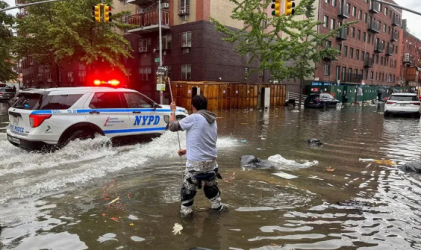NEW YORK, Sep 30 (APP): Heavy downpours triggered flash flooding in New York on Friday morning, disrupting life, flights, and subway service in the United States’ most populous city and turning many of its streets into small lakes.
Towards Friday evening, the extreme rainfall eased, but officials warned that flood risks remain.
More than 7.25 inches of rain had fallen in parts of Brooklyn, a borough of New York City, by nightfall, with at least one spot seeing 2.5 inches in a single hour, according to weather and city officials.
The 8.65 inches at New York’s John F. Kennedy Airport surpassed its record for any September day, a bar set during Hurricane Donna in 1960, the National Weather Service said.
A flash flood warning remained in effect for New York City, with the National Weather Service advising citizens to “Move to higher ground now. Act quickly to protect your life.”
The extreme rainfall prompted New York Governor Kathy Hochul to declare a state of emergency for New York City, and its suburbs of Long Island and the Hudson Valley.
“Please take steps to stay safe and remember to never attempt to travel on flooded roads,” she said in a message posted on the X social media platform.
Some 18 million people in the New York metropolitan area and in other major cities along the East Coast were under flood warnings, watches and advisories from the weather service, while at least one terminal at LaGuardia Airport was closed on Friday.
As the planet warms, storms are forming in a hotter atmosphere that can hold more moisture, making extreme rainfall more frequent, according to atmospheric scientists.
But in the case of Friday’s storm, nearby ocean temperatures were below normal, and air temperatures weren’t too hot. Still, it became the third time in two years that rain fell at rates near 2 inches an hour, which is unusual, Columbia University climate scientist Adam Sobel said.

